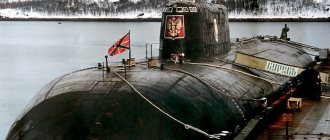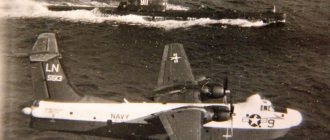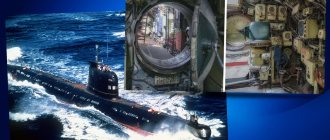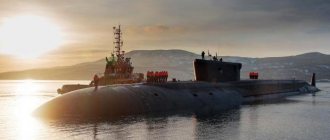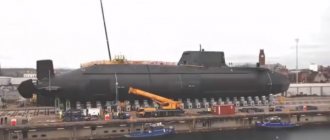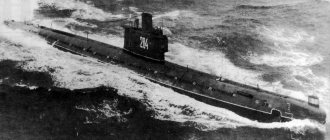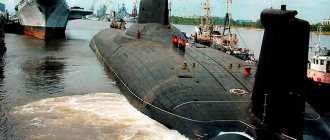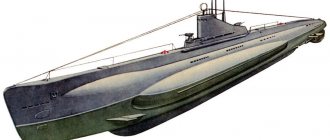Submarine K-141 "Kursk" is a nuclear submarine with cruise missiles (APRK) of project 949A, military unit 20826 (Vidyaevo), code "Antey" (NATO designation - "Oscar-II"). The submarine "Kursk" was laid down in Severodvinsk (PO "Northern Machine-Building Enterprise", serial number 662) in 1992, launched in May 1994, and put into operation on December 30, 1994. From 1995 to 2000 - as part of the Russian Northern Fleet. Sank in the Barents Sea, 175 km (as the crow flies) from Severomorsk, (69.666667, 37.58333369°40′00″ N 37°35′00″ E / 69.666667° N 37.583333° E .) at a depth of 108 meters as a result of the disaster that occurred on August 12, 2000. According to the official version, at 11 hours 28 minutes 26 seconds Moscow time, a 65-76A (“Kit”) torpedo exploded in torpedo tube No. 4. The cause of the explosion was a leak of torpedo fuel components (hydrogen peroxide). After 2 minutes, the fire that arose after the first explosion resulted in the detonation of the torpedoes located in the first compartment of the submarine. The second explosion was equivalent to the explosion of 2-3 tons of trinitrotoluene (TNT) and led to significant destruction of the boat. All 118 crew members were killed.
Technical characteristics of the Kursk submarine
Ship type: SSGN Project designation: 949A “Antey” NATO classification: “Oscar-II” Speed (surface): 15 knots Speed (underwater): 33 knots Operating diving depth: 420 m Maximum diving depth: 500 m Navigation endurance: 120 days Crew: 130 people Surface displacement: 14,700 t Underwater displacement: 23,860 t Maximum length (according to waterline): 154 m Maximum beam of hull: 18.2 m Average draft (according to waterline): 9.2 m
"Antey"
This is what the Project 949A nuclear submarine missile-carrying cruisers are called.
These boats are also proudly called “aircraft carrier killers.” Be that as it may, Project 949A Antey submarines are very powerful ships carrying deadly weapons. The boat is double-hulled: its design includes a lightweight outer hull and a durable inner hull. The distance between them is 3.5 m, and this feature increases the chances of surviving a collision with another submarine. The submarine's hull is divided into ten compartments. Project 949A boats are very wide and can lie on the ground if necessary.
Project 949A Antey boats were built in a fairly large (by nuclear submarine standards) series, including eleven submarines. Currently, eight more of these boats continue to serve in the Northern and Pacific fleets, and they will soon be supplemented by the K-139 Belgorod. Their partial replacement will be Project 885 Yasen submarines.
©NS
Service history of the submarine "Kursk"
The crew of the submarine "Kursk" (APRK K-141) was formed in the Northern Fleet in June 1991, the first commander was captain 2nd rank Rozhkov Viktor Nikolaevich.
In April 1993, in honor of the feat of the Soviet people on the Kursk Bulge during the Great Patriotic War, by directive of the Commander-in-Chief of the Navy, K-141 was given the honorary name “Kursk” .
In August-October 1999, the submarine took part in an autonomous voyage to the Atlantic Ocean and the Mediterranean Sea. Secret surveillance was carried out over the grouping of the US Navy's Sixth Fleet in the Mediterranean Sea, which included the aircraft carrier Theodore Roosevelt, from which aircraft attacked Serbia during the NATO operation against Yugoslavia. During the Mediterranean campaign, the Kursk carried out 5 simulated attacks on real targets. As a result of the voyage, 72 crew members were nominated for government awards. The captain of the nuclear submarine "Kursk" was nominated for the title of Hero of Russia. "Kursk" is noted as the best submarine of the Northern Fleet.
On July 30, 2000, the Kursk took part in the naval parade dedicated to Navy Day in Severomorsk.
On October 15, 2000, an aircraft carrier maneuver group of the Northern Fleet, including the Kursk submarine .
Memory
August 23, 2000 is a day of national mourning. In honor of the anniversary of the rise on the 4th line of Vasilyevsky Island (St. Petersburg), an interactive exhibition has been opened. The Bosse mansion, provided by A. Rosenbaum, was decorated in the form of the sides of a boat, underwater footage was shown on the screens, and the exhibits were real things from the ship.
A fragment of the felling was installed near Murmansk in 2009 on the site of the Church of the Savior on Water. A monument to sailors who died in peacetime was also unveiled there. And in other cities they honor the memory of “Kursk”:
- ZATO Vidyaevo (home port of APRC) - annual commemorative events;
- Sestroretsk - the chapel of St. Nicholas the Wonderworker was built in memory of the sailors;
- With. Loskutovo, Kirov district, Tomsk - memorial plaque to A. Neustroev (served on a submarine on his own initiative);
- Yemva, Komi Republic - memorial plaque to A. Larionov (lived in a house on Pervomaiskaya street, 26);
- Nizhny Novgorod - the monument was installed at the Maryina Roshcha cemetery (three submariners were buried);
- village Gerasimovo, Suvorovsky district, Tula region. - a chapel with a mourning plaque on which there is a photo of 118 people. On August 12, 2003, a monument with an anchor sent by the Navy was unveiled;
- Volgograd - in honor of the former student G. Lyachin, school No. 85 was named and a museum was opened;
- Marganets, Dnepropetrovsk region, Ukraine - at secondary school No. 11 there is a memorial plaque in honor of the former student V. Belogun;
- Energodar, Zaporozhye region, Ukraine - a monument to S. Loginov next to the Harmony gymnasium, where he studied.
A piece of metal from the casing serves as a memorial and at the same time an exhibit of the “Museum of Water Disasters” in the lighthouse church in the village. Malorechenskoe (Crimea).
Disaster of the submarine "Kursk"
Exercise 2000
According to the exercise plan, the Kursk was supposed to begin preparations at 9:40, and from 11:40 to 13:40 carry out a training attack on an aircraft-carrying group of ships. The last entries in the logs are marked 11 hours 15 minutes on August 12, 2000. In 2002, the Commander-in-Chief of the Russian Navy, Vladimir Kuroyedov, said that during the preparation the command had committed a number of violations that did not contribute to the favorable conduct of the exercises, but were not the cause of the accident. On board the submarine there were 24 P-700 Granit cruise missiles and 24 torpedoes. It was necessary to launch a cruise missile and fire torpedoes at a training target. The ascent and communication with the report was planned for 13 or 15 hours. The ship was commanded by Captain 1st Rank G.P. Lyachin.
Armament
The Kursk nuclear submarine had formidable weapons, the basis of which were 24 supersonic cruise missiles of the P-700 Granit complex, which were located on both sides of the wheelhouse in launch containers.
Open launch containers (on both sides of the wheelhouse, using the example of the Omsk nuclear submarine)
Combat capabilities and characteristics of the P-700 complex
| Number of missiles, pcs. | 24 |
| Rocket name | ZM-45 |
| Container tilt, degrees. | 40 |
| Engine type and name | Sustaining turbojet KR-93 with annular solid-fuel rocket booster |
| Warhead weight, kg | 750 |
| Explosion power of a nuclear warhead, Kt | 500 |
| Range, km | 550 |
| Speed, m/s | 2.5 |
| Rocket mass, kg | 7000 |
| Rocket length, m | 19.5 |
| Case diameter, m | 0.88 |
| Wingspan, m | 2.6 |
It is worth noting that the features of the complex are:
- Possibility of simultaneous salvo of missiles with sequential distribution of targets;
- High probability of overcoming enemy missile defense and air defense, taking into account supersonic speed, high maneuverability and trajectory change by ZM-45 missiles;
- Radio silence when flying on the main route.
To destroy underwater and surface targets, there were 4 torpedo tubes of 533 mm caliber and 2 torpedo tubes of 650 mm caliber on board the submarine. The ammunition load is 24 torpedoes.
| Type and caliber | Homing or remote-controlled, anti-submarine, anti-ship - 533 mm Homing boat anti-ship - 650 mm |
| Diameter, mm | 533/650 |
| Length, m | 7.7/11 |
| Total weight, kg | 2000/4100 |
| Weight of warhead, kg | 400/nuclear charge |
| Range, m | 14 215/ 50 000 |
| Speed, knots | 50 |
Torpedo 53-38 caliber 533 mm
Torpedo 65-76A 650 mm caliber
Possible causes of the death of the Kursk submarine
Explosion of a training torpedo
The 2,000-page official report, published in 2002 by Prosecutor General Ustinov, states that the sinking of the Kursk was caused by the explosion of a training torpedo that exploded in the torpedo compartment. Hydrogen peroxide torpedoes have not been used in most navies of the world for more than 50 years precisely for reasons of safety and reliability, but the Kursk had such torpedoes - model 65-76 "Kit", developed in 1976 - since they are cheaper than torpedoes with expensive silver-zinc batteries. Soon after the investigation, the hydrogen peroxide torpedo, which they tried to return to the fleet in order to save money, was finally withdrawn from service.
Version of Vice Admiral Ryazantsev
According to Valery Dmitrievich Ryazantsev, who was a member of the government commission to investigate the causes and circumstances of the Kursk submarine , the cause of the first explosion was the so-called “thick” torpedo 65-76 PV, replenished with non-degreased high-pressure air on August 11, 2000. Until August 12, degreased air could not get into the oxidizer tank, since the practical torpedo was on the rack, the air lock valve on it was closed, and safety devices were installed on the air trigger valve. An uncontrolled decomposition reaction of hydrogen peroxide began after loading the torpedo into the torpedo tube. Due to a design flaw in submarines of this class, the crew, in order to prevent an increase in pressure in the 1st compartment during salvo firing of torpedoes, leaves the flaps of the ship's general ventilation system open, as a result of which the shock wave from the explosion of the 65-76 PV torpedo hit the 2nd compartment and the entire personnel The crew of the command compartment received severe concussions and found themselves inoperable. The second explosion, according to Valery Ryazantsev, occurred due to a collision of the nuclear submarine with the ground, and not as a result of a volumetric fire in the first compartment - the K-141 Kursk nuclear submarine, with the first compartment filled with water, at a speed of about 3 knots, with a trim of the nose 40-42 degrees at a depth of 108 meters collided with the ground. Torpedo tubes No. 1, 3, 5 and 6 with live torpedoes equipped with fuses were crushed and destroyed, which caused the explosion of the live torpedoes.
Torpedoing
Immediately after the disaster, several admirals and officials claimed that the Kursk was torpedoed by an American submarine. Then this version began to be kept silent in favor of the official version. However, French director Jean-Michel Carré, in his film “Kursk: A Submarine in Troubled Waters ,” which was shown on January 7, 2005 on French television France 2, claims that the Kursk was torpedoed by the American submarine Memphis. According to his version, the Kursk carried out a demonstration shot of the new Shkval torpedo; these tests were observed by two American submarines, Memphis and Toledo. "Toledo" was moving dangerously close under the cover of "Memphis", which was "in the shadows". At one point, the Kursk and Toledo collided (video footage of the Kursk the Kursk from firing at the Toledo (it is assumed that the opening of the torpedo tube was heard apparatus "Kursk" ), "Memphis" opened fire with a Mk-48 torpedo at "Kursk" . Carre claims Russian President Vladimir Putin deliberately hid the truth about what happened to prevent relations with the United States from worsening sharply. Canadian documentarians and some retired military officers adhere to the same version.
When analyzing the version of the torpedoing of the Kursk APRK, it is necessary, however, to take into account that the information in the film directed by Carre is called official, in fact, in the first days after the tragedy, it was put forward in a speculative manner along with other versions, including the most incredible. The materials available today do not provide grounds either for its confirmation or for its complete refutation. Strictly speaking, even in the French film itself, the only factual evidence of its plausibility (but not absolute fidelity) is a freeze frame that captures a hole on the hull on the right side. However, this hole is located in close proximity to the cut line of the bow compartment, but there are no obvious signs of the origin of this defect from a torpedo hit. As a result, it can be assumed that it could have formed either as a result of a torpedo hit, or as a result of the ship touching the ground after an explosion, during lifting and towing operations, when placing the boat in a dock, etc. It cannot be ruled out that the primary deformation the hull in this place could have formed during the normal operation of the nuclear submarine (due to careless mooring, etc.). In addition, an attentive viewer will notice that the film directed by Carré is made rather carelessly, is replete with inaccuracies and aims to achieve quick commercial success. Among the obvious inconsistencies: a message that the remains of the first compartment were blown up on the seabed after the completion of work on raising the rest of the hull; the phrase that Norwegian divers opened the emergency hatch without problems (no one argues with this, but the problem was that it was impossible to ensure a hermetically sealed connection of the rescue apparatus to the Kursk in the area of the hatch due to the deformation of the hull that occurred as a result of the explosion). the Kursk looks absolutely fantastic : after all, they not only have a different model and type (at the Chernobyl nuclear power plant there was a RBMK-1000 channel boiling uranium-graphite reactor, on nuclear submarines they were used water-cooled thermal neutron reactors OK-650V), but also in size, which is understandable even to a schoolchild. It is possible that the authors confused the nuclear reactor on the Kursk submarine with the reactor at the nuclear power plant in Kursk, where the RBMK-1000 is actually installed.
Mine from the 2nd World War
Deputy Prime Minister Ilya Klebanov expressed a version of the collision of the Kursk with an anti-ship mine from the Second World War, which may have also led to the detonation of the torpedo. After choosing the official version of a “torpedo explosion,” the assumption disappeared by itself. Experts familiar with the strength characteristics of nuclear submarines of this class initially rejected this version.
Collision with an underwater object
One of the members of the state commission who accepted this submarine from the industry, captain first rank Mikhail Volzhensky, believes that the torpedo in the apparatus could have become jammed due to a strong mechanical impact on the hull of the Kursk . Volzhensky considers the most likely cause of the disaster to be a collision with a foreign submarine. In his opinion, “the glancing blow of the steering feather (horizontal rudders) could lead to severe deformation of the Kursk .
This conclusion is very similar to the probable causes of the Kursk , stated on November 29, 2000 in Nezavisimaya Gazeta. Indeed, both practical torpedoes: USET-80 and 65-76, as a rule, are loaded into the right torpedo tubes. In a collision at an acute heading angle with a foreign nuclear submarine, the first to be crushed would be the right outer 650 mm caliber tube, in which the practical 65-76 torpedo lay. At a speed of relative approach of the submarines of about 20 knots (10 m/s), this TA was crushed together with the torpedo in one second. During this second, almost instantly, the entire supply of fuel (kerosene) and oxidizer (hydrogen peroxide) was combined in a closed volume, which led to their explosive ignition, enhanced by the explosion of the powder accelerator installed in the tail of the torpedo. The pressure of the hull of a foreign nuclear submarine from the head of the torpedo to its tail directed this explosion (equivalent to the explosion of 150 kg of TNT, as recorded by a Norwegian seismic station) to the rear cover of the torpedo, which was torn out, and the force of fire hit the first compartment, which instantly led to a fire.
The commander of the Northern Fleet, which included the Kursk, Admiral Popov also expressed strong confidence in this version. According to him, an unidentified submarine unintentionally hit “the most vulnerable spot of this submarine project,” as a result of which, having lost buoyancy, it hit the ground with high speed and trim, where an explosion of torpedo ammunition occurred.
Rocket hit
Captain First Rank Alexander Leskov, pointing out that a submarine of this size had no right to be underwater in this place for physical reasons, suggested that the boat was hit by an anti-ship ballistic missile launched from the Plesetsk cosmodrome. However, the chairman of the St. Petersburg Club of Submariners, Captain 1st Rank Igor Kurdin, said that this version is “complete nonsense.”
On September 8, 2000, an article appeared in the Berliner Zeitung newspaper with the version that the Kursk was sunk by an accidental hit by a P-700 missile equipped with a new warhead designed to destroy underwater targets, launched from the nuclear-powered missile cruiser Peter the Great. . This version became silent due to the fact that it could “discredit the entire Russian military command.” This version does not explain the origin of the hole. In addition, the Russian armed forces do not have such a “diving” modification of the P-700 anti-ship missile. Another version seems more reasonable - the Kursk , which was on the surface, was hit by an unexploded/without warhead P-700 missile launched from Peter the Great or launched by the boat itself and returned as a result of a malfunction. The penetrating warhead of the missile hit the submarine in the area of the starboard side (hole), after which the remaining missile fuel ignited from the engine that continued to operate. The fire that started caused the torpedoes to detonate, causing a series of explosions.
Climb
Before the start of Operation Kursk, it was necessary to thoroughly inspect from the outside and near the flooding point, and check for radiation. Two expeditions were sent in September and October.
Kursk Raising Project
The APRC had to be lifted without trim or roll - the Kursk had lost some of its mechanisms, and the hull could have collapsed. In addition, the state of the torpedo stock was not known.
The Dutch company Mammoet Transport BV in February 2001 proposed lifting with hydraulic jacks with dynamic compensators for the forces of lifting the submarine off the ground. The mechanism of the device operates on the basis of nitrogen compensation, which creates shock absorption for the jacks and ensures vertical movement of up to 2 m under dynamic forces.
Central Design Bureau "Rubin" together with the Institute named after. Krylov, Navy Institutes No. 1 and No. 40 created a lifting capture system. The principle of operation of the design was to make holes in the hull between the frames and introduce hooks with moving parts into them. Experts calculated that the body and partitions could withstand the load.
The project had some technical nuances:
- the difficulty of calculating the force of attraction of a submarine to the ground even after studying its composition;
- the separation of the first compartment, which could lead to a new accident - it was simply sawed off.
After discussions, the experts decided to first put a load on the lifts of half the weight of the vessel, wait 6 hours and gradually increase the load on the stern. The first compartment was cut off.
The work plan was presented to President V. Putin by the chief designer of the Rubin Central Design Bureau, I. Spassky, on August 19, 2000.
Interesting to know! Putin asked Spassky if he could cope with the task. He, although he was not confident in his abilities, answered “Yes, I can.” As a result, the Kursk was raised.
Preparatory work
In October 2000, during Operation Regalia, the submarine's hull was opened and a search for the bodies of the dead began. The tasks were carried out by Halliburton (USA) and specialists from Russia. Divers extracted 12 sailors from the 9th compartment, including D. Kolesnikov.
Compartment No. 1, deformed from the explosion, needed to be separated and holes made for hooks. They worked using the technology of cutting a large pipeline. The saw was assembled from cables with strung cylinder parts and asymmetrical sharp elements of different heights. Cylindrical towers with an upper bottom were placed near the sides and guide wheel blocks were attached to them. The running parts of the saw and hydraulic cylinders were placed on blocks.
As the water was removed under force, the upper bottom of the tower sank, pressing it into the ground. The saw was thrown over the top of the ship, the cable kept breaking.
The operation was carried out by the Carrier barge and the Mayo ship in late summer 2001. The process was recorded by V. Fedko’s film crew. At the final stage, the Prosecutor General tried to ban filming, but the group received permission. V. Fedko was awarded the award “For the rise of Kursk”.
Barge Mamut for lifting
Technical means used to lift the Kursk
All equipment was located on the Giant 4 barge with a reinforced hull. The ship was equipped with 26 jacks and compensators with large-diameter coils. The systems were controlled from the remote control. The barge also had living quarters and storage for materials.
Each of the jacks used 54 strands - cables 18 mm in diameter. They consisted of 7 rods - a central, cylindrical and 6 trapezoidal ones, wound on coils 3 m in diameter. The working units were passed from the jack through a sluice-pipe attached to the barge hull.
The bottom of the vessel has been modified to suit the submarine's configuration. A special depression was intended for cutting; there were “saddles” along the entire length. By the force of the jack, the barge increased the draft and tore the APRK off the soil. She, in turn, was pulled to the bottom by cable jacks.
The hooks to the holes were released along 2 guide cables attached to the basket ring above the cutout in the boat hull. The legs of the wound hooks were moved apart by hydraulic mechanisms and fixed with stoppers.
To bring the Kursk into floating dock No. 50, it was necessary to make 2 pontoons in the shape of the letter L (developed by Mammoet Transport BV). They made it possible to launch a barge with a draft of 20.7 m with a permissible draft of 14 m, lifting the Giant-Kursk coupling weighing 19.5 tons by 7 m.
The control system for expansion joints and jacks was developed by lgH (Germany), the mechanisms and equipment were supplied by Hydrospex (Holland), and the hooks were supplied by the Dutch company Huisman. Seaworthiness tests and bond strength testing were carried out by the Central Research Institute named after. Krylova. The pontoons were also manufactured in the Russian Federation at the Sevmash enterprise.
View from bow to stern. The remains of the flooring are visible.
Methods
To extract the K-141, a platform based on the Giant 4 barge with an additionally reinforced hull was used. This made it possible to withstand the weight of 26 jacks with coils, energy and working media. Bundles of strands passed through a sluice pipe specially welded onto the barge hull. Changing the contour of the bottom ensured that the Kursk was detached from the surface and was attracted to the bottom of the barge.
Experts have considered a “back-up plan” in case the nuclear-powered icebreaker cannot get off the bottom. They planned to install a cable under the stern, securing it to the tugboats Artek and SmitWijs Singapore. If necessary, they could stretch the cable under the keel. The first compartment was cut off because... if it fell off, it would provoke another catastrophe.
Boat after the disaster
Results of the Kursk recovery operation
After the operation, 115 bodies of submariners were found, evacuated and buried. 3 bodies were not found. A potentially dangerous supply of torpedoes and 2 nuclear reactors were also recovered. The submarine was studied in detail in a dry dock, which provided the opportunity to investigate the circumstances of the death and the last days of the crew’s life.
As of March 2009, all that remained of the submarine was a block with 3 compartments, from which the reactors were removed. The felling fence was separated and transported to Murmansk.
Rescue work
Rescue operations were carried out by the Northern Fleet and took place from August 13 to 22, but were unsuccessful. Underwater vehicles (autonomous projectiles) AS-15, AS-32, AS-34 and AS-36 were used. All attempts to suction the boat to the coaming platform were unsuccessful, since the rubber anti-noise coating did not properly cover the hatch coaming platform and interfered with docking. On August 20, the Norwegian vessel Seaway Eagle joined the work, divers from which were able to open the aft rescue hatch of the Kursk the next day.
Torpedo attack
Much more interesting is the version about the torpedoing of the Kursk by a NATO submarine. Of course, the North Atlantic Alliance did not set out to destroy it, but in a difficult situation, when the ships were nearby, the captain of an American boat could give the order to launch torpedoes. This point of view is shared by the creators of the documentary film “Kursk. Submarine in troubled waters." According to it, the attack was carried out by the Memphis boat, a Los Angeles class boat. The Toledo boat was also present there, covering the attacking submarine.
Proof of the attack can be a hole in the front right side of the Kursk. Some photographs clearly show a circle with concave edges. But what could have left such damage? US Navy submarines use Mark-48 torpedoes, but their detailed characteristics are not known for certain. The fact is that these torpedoes have been modernized many times since they were put into service in 1972.
Some experts say that the Mark-48 hits the boat with a directed explosion and, accordingly, cannot leave such damage on board (we are talking about a flat, almost round hole). But in the already mentioned film by Jean-Michel Carré it is stated that Mark-48 has a penetrating effect and such a hole is its calling card. The film itself is replete with a lot of technical flaws, and it is very difficult to separate truth from fiction in this case. In other words, the question of a torpedo attack still remains open.
Logs and recorders of the Kursk submarine
According to the Commander-in-Chief of the Russian Navy, Vladimir Kuroyedov, in the 5th compartment of the nuclear-powered ship, where the control panel for the main power plant of the Kursk , a recorder and watch documentation heavily damaged by water were found. According to him, a search was conducted for the recorder and watch documentation in the 3rd compartment, where the combat posts of radio operators, chemists and radiometrists were located. The decoding of 22 cassette tape recordings from the nuclear-powered icebreaker "Kursk" was carried out by specialists from the St. Petersburg "Center for Speech Technologies".
It was established that on the day of the accident, the Snegir tape recording equipment, which records public address conversations, was turned off; the corresponding toggle switch was in the “off” position. According to the regulations, during the preparation of a training attack, the Bullfinch equipment must be turned on. It also turned out that the emergency buoy alarm on the nuclear-powered ship was not turned on and the emergency antenna release system was turned off for several years. The factory fastening device was not removed from the emergency buoy, which prevented the buoy from floating.
Logs from the central nuclear post, a draft logbook, and logbooks from the control of the left and right sides of the nuclear submarine were discovered. There were no records of an emergency or emergency situation. Three notes from submariners were also discovered. Based on one of the notes, an assumption was made about the absence of light and smoke in the 9th compartment.
Description of design
Design of the Kursk nuclear submarine
In the bow (torpedo) compartment there were 6 torpedo launchers, into which torpedoes were fed from the upper deck using a quick loader. The entire recharge cycle was 5 minutes. Flammable batteries are separated by a special flooring and are located on the lower deck. According to the staffing schedule, 5 sailors serve in this compartment.
The second compartment contains 4 decks, the most important being the top one. It was there that the command post was located, where the CPU and other consoles, microclimate control systems, periscopes, watch officer posts and navigation systems were located.
There is a rescue pop-up chamber in the upper compartment of the submarine.
With the help of a manual drive, it is possible to supply oxygen necessary for breathing of personnel, and float to the surface in case of flooding.
For the survival of sailors, it provides emergency supplies - an emergency supply of food, batteries, and radio communications. Most of those here are officers. There are about 30 people in total.
The radio-electronic compartment contained equipment for communications and radio reconnaissance. It was represented by radar and multi-profile antennas for space communications and receiving target designations from space satellites and an aircraft observation post.
In the living compartment, in addition to the sleeping quarters, there were:
- cabins - company;
- showers;
- gym;
- sauna;
- emotional release room (greenhouse, aquarium);
- fire extinguishing system.
In the engine compartment there was a diesel generator for generating electricity and related mechanisms, as well as fuel and lubricants. Decontamination of sailors who worked in the compartment with the reactor was carried out in compartment 5 bis.
Nuclear installations were located in compartment 6, the volume of which was 641.3 cubic meters. m.
There were 5 people on combat duty in the 6th compartment.
The volume of the turbine compartment was 1116 cubic meters. m., where there was a switchboard, an emergency control panel, an electrical station and units that ensured the movement of the submarine. All the sailors who were here moved to another compartment.
These were captain-lieutenant Dmitry Kolesnikov, senior midshipman Vladimir Kozaderov, midshipman Fanis Ishmuratov, chief petty officer Rishat Zubaidulin, foreman 2nd article Roman Anikeev, foreman 2nd article Vladimir Solovyov, sailors Ilya Naletov, Roman Kubikov and Alexey Nekrasov.
The purpose of the eighth compartment with a volume of 1072 cubic meters. m. similar to the previous compartment.
Here were located:
- turbines;
- generator to provide electrical energy;
- water desalination plants;
- power station.
The outer ninth compartment is, in fact, a shelter, where the duty shift consisted of only 3 people. In addition, there were 120 gas masks and self-rescue kits, 6 swimming boards.
Also posted:
- food supply for 6 days;
- pumps;
- electric motor control station;
- lathe;
- steering system hydraulics;
- shower cabin;
- emergency hatch with a tube for single free ascent;
- combat post for reserve rudder control.
10
atmospheres, such pressure was withstood by the bulkheads between the compartments
Each compartment was separated by bulkheads that could withstand pressure of up to 10 atmospheres. If necessary, hatches between compartments are sealed.
The high survivability of the submarine was achieved by duplicating the main mechanisms and elements (2 turbines, 2 propellers, 2 reactors)
In the event of an accident, provision was made for the use of a pop-up emergency information device, which within 5 days transmits an SOS signal and fires back on its own.
Identification of the dead
Over the course of a year, some investigators collected identification signs, interviewing relatives, friends, and colleagues of the deceased submariners, requesting information from medical institutions, even children's clinics. 9 volumes were collected. Also, forensic doctors were provided with medical books found in the 4th compartment.
As of December 19, 73 bodies of dead submariners had been recovered and 65 identified.
In February 2002, it was reported that the crew commander, Captain 1st Rank Gennady Lyachin, and the senior officer on the campaign, Chief of Staff of the 7th Division of the Northern Fleet, Captain 1st Rank Vladimir Bagryantsev, had been identified. By March 20, 2002, the bodies of 115 dead submariners were discovered and identified. The bodies of two sailors, Dmitry Kotkov (Koshkov) and Ivan Nefedkov (Nefednov), as well as the chief specialist of Dagdizel, Mamed Gadzhiev, could not be found.
According to the conclusion of a forensic medical examination, the submariners who were in the 9th compartment died from acute carbon monoxide poisoning within 7-8 hours after the disaster.
Alternative version
One of the versions was the hypothesis of captain 1st rank Alexander Leskov. In 1967, he survived a fire on the K-3 nuclear submarine, and in addition was the commander of the K-147 nuclear submarine. The officer criticized the official version, according to which the Kursk was under water during the first explosion. Having a length of 154 m, such a boat, according to Leskov, should not have dived at such a shallow sea depth (remember, it was found at a depth of 108 m). According to safety requirements, diving requires a depth of three times the length of the submarine itself.
The former submariner claims that the boat was found at the bottom with retractable devices that are raised only when the ship is on the surface. He calls the version of a torpedo explosion erroneous, since torpedoes have four levels of protection and the detonation of one of them does not entail the explosions of others.
A reasonable question arises: what then destroyed the boat? Leskov unequivocally states that it was a Russian missile launched during the exercise. It could have been a surface-to-surface coastal missile. The officer believes that the Kursk was hit not by one, but by two missiles, which was the cause of both explosions. Note that Leskov’s hypothesis, like all others, also suffers from a lack of evidence.
Trial involving Boris Kuznetsov
In 2002–2005, Kuznetsov represented the interests of victims in the criminal case “On the death of the Kursk anti-aircraft missile system and its crew members.” He sharply criticized the results of the official investigation into the circumstances of the disaster, including in his book “She Drowned. The truth about Kursk , which was hidden by Prosecutor General Ustinov.” He believed that if the Russian authorities had immediately turned to foreign help, “they would have been able to save those 23 sailors who were in the ninth compartment and lived for more than two and a half days” (according to official data, the sailors were alive only for several hours). At the same time, he agreed with the conclusions of the investigation that there was a torpedo explosion on the boat and rejected the version that it collided with an American submarine.
Authorities' reaction
The Russian government, having learned about the disaster, did not want to allow foreigners into the operation for reasons of breach of secrecy. Only on August 16, the Navy command was given presidential permission to use foreign equipment - Russia did not have the necessary life-saving equipment.
A criminal case has been launched regarding photographs of an American boat published by the Versiya newspaper. The editor of the investigations department, D. Filimonov, acted as a witness.
The official cause of the tragedy - a torpedo explosion - was announced by a government commission on June 29. The theory did not suit many and they, according to V. Putin, began to indulge in their favorite pastime - looking for those to blame. No one was punished, although, in fact, there are culprits: those who destroyed the fleet, who turned a blind eye to distress signals, and uninitiative (although there can be no initiative for paying 1.5-3 thousand rubles) employees. It makes no sense to blame these people even now: having started the search from the moment they received the signal, the rescuers would not have been able to provide assistance to the crew.
Destruction of the Kursk submarine
The first explosion caused an intense fire in the first compartment, the shock wave passed into the second compartment. The burning smell was carried through the ventilation pipelines into other compartments.
The second explosion cut off the bulkhead between the first and second compartments (the 22nd frame), which, moving like a piston, crushed the equipment and 22 mm of flooring, and cut the welds into a durable hull. After lifting, the bulkhead of the first/second compartments was found at the site of the bulkhead of the second/third compartments (43rd frame). The second shock wave was stopped only by the aft bulkhead of the 5-bis compartment. The bulkhead was bent in an arc, but it held up.
Content
- 1 How no one saved anyone 1.1 Materiel
- 1.2 What happened
- 2.1 Official version. Explosion of a training torpedo
- 2.4.1 Parsing
[edit] It would seem, what does Dorenko have to do with it?
| « | The president's version: the fleet was destroyed by people from television. | » |
| — Dorenko | ||
09/02/2000 Sergei Dorenko in a white raincoat with a bloody lining goes on air on Channel One with his author’s program “Sergei Dorenko’s Author’s Program,” dedicated to the death of the Kursk nuclear submarine. Over the next 50-odd minutes, he will persistently prove that the authorities are hiding and, in general, the death of the Kursk did not happen at all as dear Russians believe. In addition, the author masterfully goes over the president, saying a lot of very unpleasant things about him (in particular, calling Putin the main culprit of the disaster). As a result, the program actually produced the effect of a bomb exploding - although, it turns out, it became possible not only on the one hundred and first channel of Mukhosransk, but right in prime time on Central Television. Epic win.
However, the reaction of the authorities was not long in coming. Literally two days later, Dorenko flew like a rock dove from the most truthful TV channel. So it goes.
[edit] How no one saved anyone
The disaster was followed by such a monstrous number of journalists suffering from conspiracy theories, assholery and trivial FGM that few people remember what happened in those days.
[edit] Materiel
Boat. Underwater. Purpose: killing aircraft carriers. In addition to torpedoes, it is armed with 24 cruise missiles with an artificial idiot, quite capable of screwing up the adversary’s AUG air defense. Nuclear - no solarium needed. It may not surface for months. It makes little noise, since rubber is stretched over the body and all mechanisms are mounted on all sorts of springs, shock absorbers, and dampers. He rarely gets in touch so as not to be detected. During the breaks between communication sessions, even the command does not know what is happening with the boat (you can quickly swim for whores or transport a piano).
The crew is more than a hundred suicide bombers, tightly sealed in an iron pipe that can withstand up to 60 atmospheres of external pressure. Oddly enough, the gloomy Soviet geniuses at least tried to give them some hope of surviving the accident - the body is divided into sealed (one hopes) compartments. There are few ways to escape from a submarine, but nevertheless they exist.
Firstly, this is an escape capsule. A mini-submarine in which you can stuff the entire crew and hope that it will successfully shoot back, float up and not immediately sink.
Secondly, at shallow depths you can try to escape through torpedo tubes. True, at a depth of over 140 meters, only Chuck Norris will survive. Hyperbaric chamber to the rescue. Caisson disease does not strike immediately; If you move slowly, you won't get any shit, but you'll have to lie around in the pressure chamber.
And finally, the ninth compartment. Its only function is shelter. An emergency rescue hatch is cut into the ceiling, equipped with a coaming platform (to which rescue submersibles and diving bells are docked). Soviet engineers, however, vaguely realized that if this hatch was simply opened on a sunken boat, then water would pour into it and everyone would die. Therefore, a pair of rescue vehicles (AS-34 and AS-36) were included with the submarines. The devices are a small submarine with a battery power reserve of several hours and a docking module that allows you to hermetically attach to the hatch and, without getting your pants wet, pull several people out of the boat at a time. Despite the general fucked-up situation, by the time of the accident not only had the devices not been cut into scrap metal, but even about a year before that they had conducted quite successful exercises with their participation. This materiel rusted bravely on the pier of the sea terminal in Severomorsk.
[edit] What happened
A detailed chronology of events is here.
In short:
- The submariners died a couple of hours after the command finally announced the alarm, although theoretically
they could have held out for several days.
Also, theoretically
, they could leave the nuclear submarine and surface on their own, since the escape hatch of the 9th compartment was at a depth of 95 meters, and, with a strong desire, having equalized the pressure by partially flooding the compartment, it was still possible to emerge through the thickness of the icy water and survive, provided that no one would decide to change their religion in the gateway by blocking it. However, the submariners naively decided that they would be rescued and began to wait for help.
- Despite the honest and selfless work of the rescuers, the rescue operation consisted less than entirely of failures and epic failures. If the submariners had not died while recharging their breathing apparatus (see above), there was still a tiny chance: in addition to the ill-fated airlock, all nuclear submarines of the Navy on the light hull have so-called Epron baffles, where air supply devices from the diver to the compartments are located survivability of the sunken nuclear submarine, as well as the ventilation pipelines of these compartments, through which warm air can be supplied and communication maintained, but...
- The surviving submariners knocked from the bottom for two days. However, the fleet command transmitted information to them in a code, which the people at the bottom could not decipher - all the codebreakers died. Why encryption? EVERYTHING IS SECRET! Realizing that they also killed the crew with this crap, they wrote in the criminal case that the knocking came not from the submariners, but from some joker who, apparently for the sake of the lulz, went down into the hold of a surface ship and drummed for two days for the sake of the lulz about the body. According to an alternative version, the sound was made by an automatic acoustic knocker, filed to facilitate detection of the submarine in just such cases.
- After fussing with the bathyscaphes for a week to no avail, everyone realized that the polymers were completely worn out and it was necessary to open the boat. There were no divers capable of working at depths of over 60 meters in the Northern Fleet, and it was necessary, as in the good old days, to call on the Varangians, who, after fiddling around for a couple of days (of which half a day was spent familiarizing themselves with the design of the hatch), finally entered the compartment and They reported upstairs that everyone had died. We also found out the cause of the discrepancy - rubber on the edges of the site. After that, all the other boats rushed to cut it off.
- There were no drills to evacuate the boat using rescue apparatus. The docking area was not checked upon receipt from the factory. Why? Yes, because it’s classic Russian bullshit.
- No one was held accountable. Everyone who theoretically should have been responsible for the failure of nuclear-armed nuclear submarines suddenly received good positions, awards and special favor from the President of the Russian Federation, and the commander’s wife, Irina Lyachina, settled down with the government of St. Petersburg - a position was provided in exchange for silence and refusal complaints against the leadership of the Navy.
- The lawyer, who brought claims against the Navy on behalf of the family members of the deceased submariners, was forced out of the country by opening a criminal case on the topic of “Disclosure of state secrets.”
